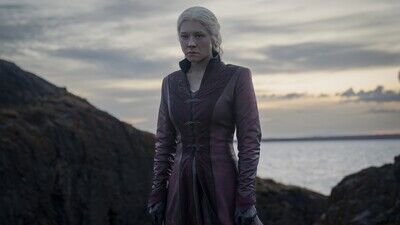We begin this new season in the north, with Rhaenyra’s eldest son Jacaerys (Harry Collett) meeting Lord Cregan Stark (Tom Taylor), who tells the prince of the night’s watch and its purpose in keeping the north—and the Seven Kingdoms—safe. As Cregan shows him The Wall, one of the great wonders of Westeros, and begins to tell Jacaerys about what horrors may lay beyond it, they are interrupted by a message: Jacaerys’ brother has been killed.
Throughout the first episode, Lucerys’ death haunts each character on Rhaenyra’s side of the war. From blame being placed on Rhaenys (Eve Best) by Daemon (Matt Smith)—whom he tells could have solved the war if she had simply “Dracarys” in the first season’s penultimate episode—to Rhaenyra who diligently searches the skies and the waters below for a physical confirmation of her son’s death, his memory remains present in the mind of each of his family members who want nothing more than to avenge him.
In King’s Landing, the news of his death brings a sense of uncertainty. Alicent (Olivia Cooke) is disturbed by the killing, but not enough to punish her son Aemond (Ewan Mitchell) who did the act. At the same time, Aemond disguises his guilt with an air of smugness that maintains the guise he puts on for his family. War looms overhead of both factions, and it becomes clear that the grief both Rhaenyra and Aegon (Tom Glynn-Carney) are holding within themselves may end up being their downfalls.

Who is fit to rule the Seven Kingdoms? That is the question that showrunner Ryan Condal seems to be posing for viewers. Is it a grief-stricken mother who, by all accounts, is the rightful heir to the iron throne? Or a young boy who would rather drink himself into a stupor than listen to his advisors? While Condal seems to be adamant that there are no “right” sides to this war, it’s glaringly apparent that actually, there is. Despite this, season two attempts to make a case for each cause, and it’s become clear that the show will try to sway viewers until its final episode.
Gone are the days of villains like Joffrey Baratheon and heroes like Daenerys Targaryen who—up until “Game of Thrones” penultimate episode in Daenerys’ case—remain perfect examples of their archetypes. While George R.R. Martin’s world of ice and fire sees more gray characters than ones who are strictly black and white, for a story like the one “House of the Dragon” is trying to portray, there need to be sides. On those sides, there must be characters for whom casual fans and longtime readers of Martin’s work can root.

